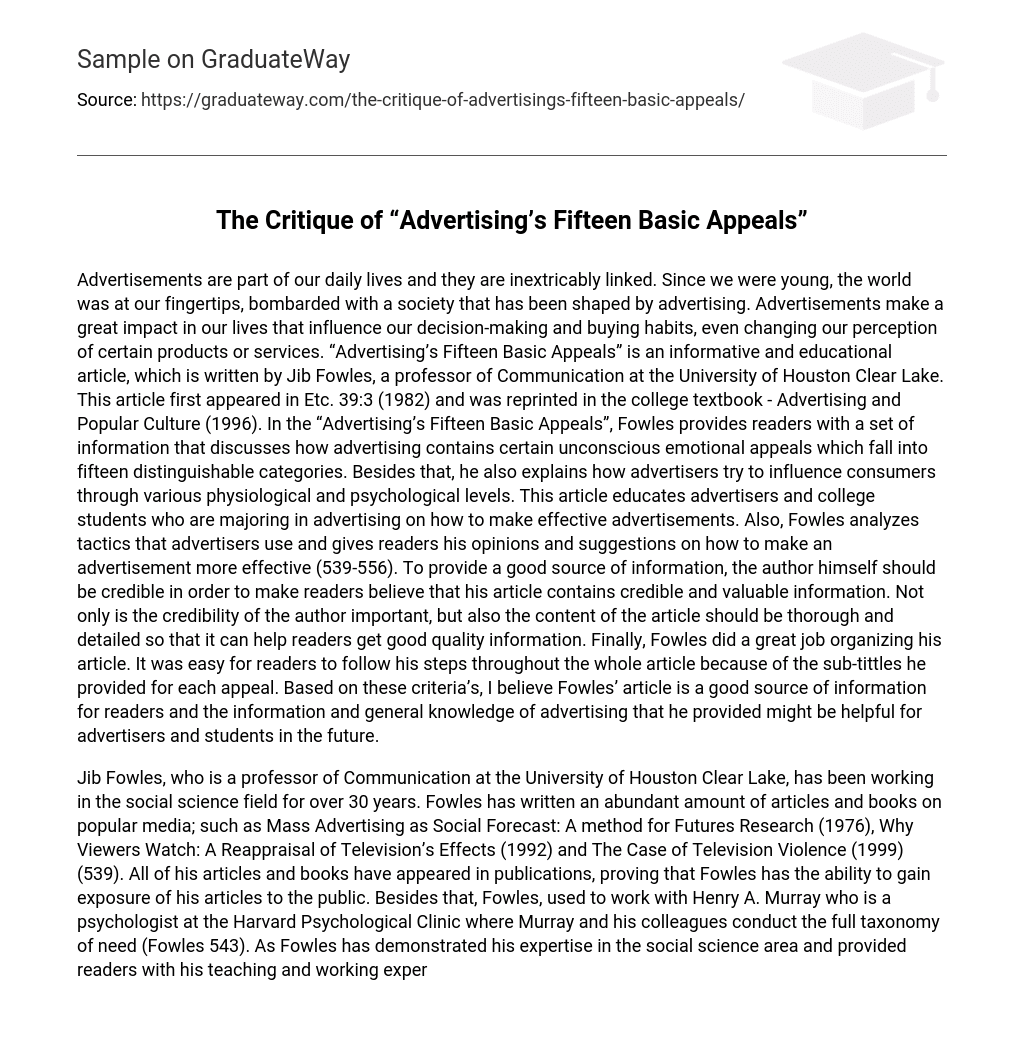The role of advertisements in our daily lives is significant and deeply intertwined. From childhood, we have been surrounded by a society heavily influenced by advertising. These ads have a profound impact on our decision-making, purchasing habits, and even alter our perception of products or services. Jib Fowles, a Communication professor at the University of Houston Clear Lake, explores these concepts in his educational article “Advertising’s Fifteen Basic Appeals”. Originally published in Etc.39:3 (1982) and later included in the college textbook “Advertising and Popular Culture” (1996), Fowles provides readers with knowledge on how advertising incorporates various unconscious emotional appeals categorized into fifteen groups. He also examines how advertisers try to sway consumers through physiological and psychological means. This article is valuable for advertisers and college students studying advertising as it offers insights on creating effective advertisements. Fowles further dissects advertising tactics and shares his opinions and suggestions on improving advertisement effectiveness (539-556).The author’s credibility and the thoroughness of the article’s content are crucial for establishing the article as a reliable source of information. Fowles’ well-organized article, with clear sub-titles for each appeal, makes it easy for readers to follow his steps. Considering these criteria, I believe that Fowles’ article is a valuable source of information for readers. The information it provides on advertising may be beneficial for both advertisers and students in the future.
Jib Fowles, a professor of Communication at the University of Houston Clear Lake, has over 30 years of experience in the social science field. Fowles has authored numerous articles and books on popular media, including Mass Advertising as Social Forecast: A method for Futures Research (1976), Why Viewers Watch: A Reappraisal of Television’s Effects (1992), and The Case of Television Violence (1999)(539). These publications have been widely distributed, demonstrating Fowles’ ability to reach a large audience. Additionally, Fowles previously collaborated with psychologist Henry A. Murray at the Harvard Psychological Clinic, where Murray and his colleagues conducted a comprehensive analysis of human needs (Fowles 543). By sharing his expertise and professional background, Fowles establishes his credibility and trustworthiness.
Fowles, an informative author, ensured that his readers grasped his points easily by providing thorough and detailed information. He compiled a list of the fifteen basic appeals of advertising, described each one, and included examples from contemporary print and broadcast ads (542-56). This approach made the ads more relevant and applicable to readers’ daily lives. For instance, he defines the need to achieve as the aspiration to accomplish difficult tasks, overcome obstacles, attain a high standard, excel oneself, rival, and surpass others (548). Fowles provides his readers with various examples of products that effectively advertise themselves by connecting with consumers’ desire for success (549). Moreover, advertisers employ messages, both apparent and hidden, to stimulate wants associated with these needs, indirectly influencing consumers’ decision-making. In this article, Fowles also expresses his thoughts on the tactics used by advertisers and discusses different advertising styles. He explains how effective advertisements function and their impact on consumer perception of specific products (542-56). The information shared by Fowles generates interest among readers, leaving them craving for more.
“Advertising’s Fifteen Basic Appeals” article is well organized, making it a reliable source of information. Fowles utilizes bold headings, small titles for each appeal, and a list to systematically present the appeals he discusses (540-556). This approach allows readers to easily follow his messages and digest information. Instead of presenting all appeals in a single paragraph, Fowles separates them into individual paragraphs based on their respective titles (543-53), enabling readers to quickly locate specific information by searching for titles that interest them. A captivating title grabs the reader’s attention and prevents the content from misleading them.
While these criteria can support the claim of this article being a reliable source of information, it is possible that the provided information may be outdated and no longer valid. Given its existence for over 30 years, both the advertising platform and society as a whole have undergone significant changes. The examples presented by Fowles may not be relevant to the reader’s current life, making it challenging for them to grasp the relevance of such outdated information. However, fundamental human needs remain consistent over time (542-53). Readers can still comprehend appeals and create new examples applicable to their own lives. The issue of outdated information might not invalidate Fowles’ article substantially; nonetheless, it prompts readers to contemplate how they can apply familiar advertisements to fulfill their needs.
The article “Advertising’s Fifteen Basic Appeals” by Fowles is a timeless resource for advertisers and advertising students. It reveals that we encounter numerous advertisements daily, but only a handful manage to capture our attention. Fowles’ article aims to illustrate the effectiveness of these fifteen basic appeals in creating impactful advertisements. I consider Fowles’ article to be a valuable source of information, as it offers both valuable insights and the author’s general knowledge of advertising that can be applied in our future endeavors.





